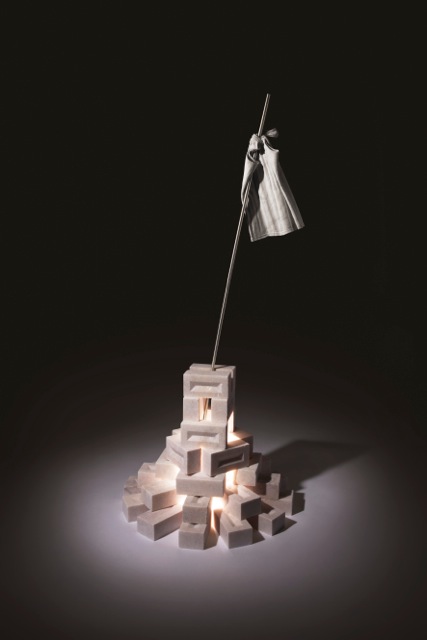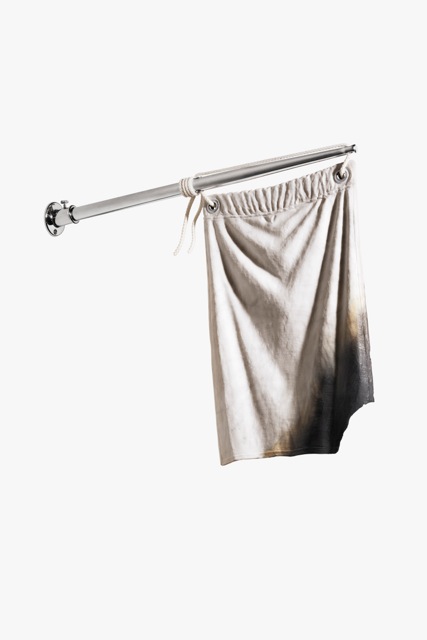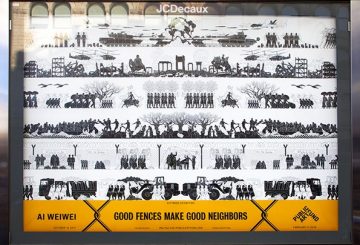Sculptor Alex Seton’s new exhibition ‘Flags’ opened this week at Sullivan and Strumpf in Sydney. Always intrigued by Seton’s practice Sharne Wolff decided to ask him a few questions about marble and politics…
Sharne Wolff: I understand that your skills in sculpting stone are self-taught – Is that right, and how did you come to have an interest sculpting marble in particular?
Alex Seton: Actually I have never claimed to be self-taught, that’s a romantic narrative people like to tell. Self directed, sure, but I have met inspiring individuals and sought out advice and practise with artists and teachers. I’ve also worked alongside and learned from experienced carvers and artists in a number of residencies and symposiums overseas. I painted, photographed and performed for many years but marble carving formed the core of my practice after years of Art Theory and History at COFA – the attraction was not only its incredible plasticity as a sculptural medium, but also its loaded history; to intercede with those expectations inherent to the medium and to engage current concerns in that dialogue. There certainly is a satisfying sense of continuum with marble carving; reclaiming the medium from the parameters and definitions of the past. The constant redefining of ourselves and our relationship with the natural world is what makes human activity so interesting.
Alex Seton, Brick Pile Monument Series: Blood Sweat and Tears 2011 Bianco marble, Queensland Pearl marble, steel rod, lighting, 220 x 120 x 120cm
SW. You’ve had a solo show almost every year since 2004 giving you the reputation of being quite prolific. How long does it take to make a piece – say a flag like that in ‘Six More’?
AS: I get asked a time-scale for pieces quite a lot, and I have to avoid the temptation to answer facetiously and say ‘thirty four years’ (my age). I’ve also learnt people get quite disappointed if you give them a small timeframe. Each piece varies, depending on what’s required for the physical realisation of an idea. Material and scale (the smaller works take longer – as anti-intuitive as that sounds) are the main factors. Since ‘Six More’ is an exercise in repetition and reproduction of the same folded flag over and over for accumulative impact (to emphasise the sheer number of Australian casualties in the ongoing Afghanistan conflict) the first piece took a lot longer than the twenty-ninth.
SW. Which artists (if any) do you admire?
AS. Many Australian artists; Caroline Rothwell, Ricky Swallow, Hayden Fowler, Natalie Ryan, Nell, Guo Jian, Patricia Piccinini and Stephen Birch to name but a few. Of the internationals, the works of Not Vital, Claes Oldenburg, Richard Serra and Andy Goldsworthy are amongst my all-time favourites, and I can’t help but admire the carving of Christian Lemmerz and Fabio Viale. All of these artists engage with the materiality of their environment and explore the fabric of this existence. I prefer artworks of long contemplation, and abhor novelty – novelty is a concept of commerce, not an aesthetic concept.
SW. Is working the way you do a lonely process? Are there other particular disadvantages in the method?
AS. Carving means long hours of concentrated decision making, so there is little time for loneliness. However I’ve really appreciated having assistants in the studio in the last two years to alleviate the labour and the monotony. Time removed is a danger, as the risk of becoming isolated and disengaged from the world is bad for the health of an artistic practice, let alone healthy living generally!
Alex Seton, No Surrender, Bianco marble, eyelets, watercolour, steel, halyard 50 x 30 x 4cm each.
SW. Some very famous works in art history – such as the painting by Rene Magritte ‘This is not a Pipe’, and Jasper Johns’ ‘Flag’ play with contradiction and paradox – both stating what they are in fact whilst being something else at the same time. Do you enjoy fooling people or is it all just about creating a sense of ambiguity?
AS. Definitely the ambiguity. Trying to explore that nexus point between the literal and the metaphor, to have a sculptural object exist in that space where it is both and neither at the same time – the anti object if you will. If it were not so dependent and driven by technology, and perceived through that frame, I would consider moving over to holographics in a flash.
SW. The optical illusion in your sculptures means they are very tempting to touch – breaking down the idea that they are like ‘art’, which typically sits on a pedestal with a sense of (reverent) space around it. At the same time, although the works are obviously very robust I’ve watched people gasp, and approach them with trepidation. What do you think about this ability your work possesses to engage with its audience?
AS. Transformation of material is fascinating way to engage the audience. To hit the perceptual reset button can engage the critical and conceptual faculties and allow concepts to flow back and forth between the art object and its audience. I loved and struggled with performance art as it overcomes its absence of a Promethean arch to engage its audience. Confronting can work wonderfully – but it can also close as many shells as it opens.
SW. Is there any idea you have tried to work with in marble and failed?
AS. Almost too many to name. I’ve produced many works over the years and I can certainly say that there are some that should have stayed in the studio. The laborious nature of the medium has less room for spontaneous emotive self-expression, but I’m ok with that, as I’m not that kind of artist. Logistically marble is very limiting, but sculpturally it is incredibly plastic and malleable. Conceptually it contains the ability to engage with concepts far more viscerally – ideas of temporality, mortality, history, fragility, reality and the ‘concrete’ are bound to the material for me. Context of its usage also plays an important role for me too – particularly the contrast of the analogue to the highly digital world. I’ve failed a few times at the combining the marble object with live and video performance, but that’s not to say I won’t try again. As a medium it’s very quiet and slow in a world of instant mediums shouting and competing for attention.
SW. Earlier shows perhaps dealt more with the illusory nature of the work sometimes in an apparent light-hearted fashion. Your new exhibition ‘Flags’ focuses more overtly on the political – war, immigration and nationalism in particular. Would you say this is a marked change in direction, or a necessary evolution?
AS. Certainly the earliest work was obsessed with perception, and carried that out in a playful fashion. I’ve certainly tried to maintain the playful as a necessary aspect to remain productive and vital and to continue to create with pleasure without drying up. But the political is not a recent change in my work- since shows like the Green Zone (06) Security Blanket (07), and Panoply (07) I’ve created shows that engage with political themes- shows about armaments, security, political shows of force, issues of nationalism and nationhood. The evolution has been the ability to do this more pointedly and effectively.
SW. Do you have any need to express your feelings about the issues you’ve touched on in this work in any other way – or is art enough?
AS. Art is definitely enough. The realm of possibilities seems endless- that’s not to say it’s without limitations. Certainly political artwork can be very limiting- it can have a tendency to preach only to the converted, to resonate only with those who think similarly already. Artist’s statements and public talks (which I enjoy) can serve to elucidate upon the thinking behind a work, but good work contains the vitals of the experience already. My first artworks as a kid were anti-nuclear protest placards, and I am certainly still interested in the power of the symbol to illuminate and ignite ideas forward. I was a song and dance man once – but that has its own limitations. Maybe stand-up comedy, but then I would feel compelled to try to be funny.
Alexander Seton
Flags
Sullivan & Strumpf, Sydney
Until 19 November 2011.




Pingback: Alexander Seton’s new exhibition: ‘Flags’ « Wolff.